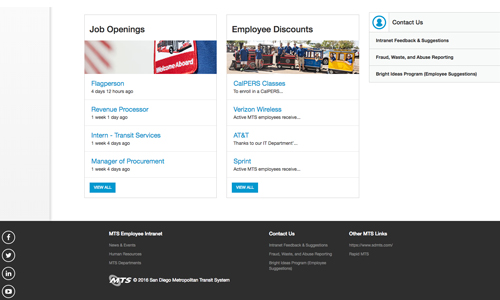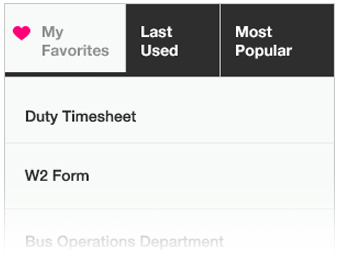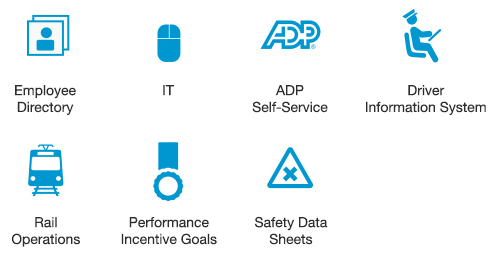You are here
Catching up on Culture of MTS Train Operators
It’s all about visibility and sightlines when a train operator gets into the cab. Operators must process important visual cues to safely carry 125,000 passengers each day.
It’s a split-second analysis of switches, indicators, crossing gates, pedestrians, automobiles, bicycles, construction zones, and more, all while maintaining safe speeds and a 90% ontime performance. The processing can seem mind-numbing at times. But Train Operators depend on their training, each other for support, and also credit the team’s diversity as the backbone for a successful operation. “We need to lean on each other,” said Tojo Clemons, a 22-year Train Operator. “Think about all the hundreds of people we are carrying in a single trip. That’s a lot of lives in our hands.” Clemons also praised the wide array of train operator backgrounds that keeps the department tight-knit. “You have a mix of everything here. Different food, different personalities, different languages, ideas and cultures. We share all this and pull for each other. The diversity breeds success,” said Clemons.
“I say hello to at least 25 different employees every day. I spend a lot of time here. So it becomes a family,” added Train Operator Christina Sanchez. “Most of the operators spend more time here than with their families,” said Superintendent of Transportation Brian Riley. “It’s a team atmosphere regardless of position. Everyone has a role to play and everyone’s role is equally important.”
Just like Train Operators have diverse qualities and different skill sets, so do the three main Trolley lines they work on – the UC San Diego Blue Line, Green Line and Orange Line. Here are some insights shared by Train Operators about the three lines:
UC San Diego Blue Line:
- 45 minutes from San Ysidro Transit Center to America Plaza Length:
- 15.4 miles
- FY 2016 ridership: 17.8 million
The most popular line among Train Operators is the UC San Diego Blue Line. It’s the highest performing line in the system, and also the shortest and straightest. Without blind curves, operators enjoy better visibility. “The UC San Diego Blue Line is the best for making time points,” said Train Operator Dodd Den Herder. The $660 million Trolley Renewal project completed earlier this year provided many enhancements for passengers and operators, including new station platforms, tracks, signaling, switches and overhead catenary lines. “It’s nice pulling into the new Blue Line stations. Customers appreciate the modern amenities,” added Sanchez.
Orange Line:
- 53 minutes from Santa Fe Depot to El Cajon Transit Center
- 18 miles
- FY 2016 ridership: 9.6 million
Many Train Operators will agree the Orange Line presents the most challenges. It’s longer than the UC San Diego Blue Line and runs almost entirely at street level which increases the crossflow of pedestrians and automobiles. The track here is also susceptible to maintenance issues due to the East County heat. But, some Train Operators prefer this line. “It just depends on preference. Some operators have been on the same line for 10 years and want to stay there,” said Nicole Barton, a Train Operator for 2½ years.
Green Line:
- 67 minutes from Imperial to Santee Town Center Station
- 23.6 miles
- FY 2016 ridership: 12.1 million
The newest and longest line in the MTS rail system, the Green Line is home to the only underground station. The line has sweeping views along the I-8 corridor and long stretches between stations that allow operators to stay at higher speeds for longer periods. “The Green Line is long and quiet, which some operators enjoy and others find it boring. But the line has lots of character with bridges, a tunnel, and elevated guideways,” said Clemons.
MTS Trolley Shifting Personalities
MTS’s 148 full- and part-time Train Operators work in three basic overlapping shifts. The staggered shifts are a common trait in transit due to peak morning and afternoon commutes. While the shift structure is fairly consistent, Train Operators noted that passenger behavior can be distinctly different depending on time of day.
Morning: Anytime between 3 a.m. to noon. “It’s not just hop in and ride. The morning shift has to get the trains ready for the whole service day,” said Barton. This includes safety measures like confirming the trains are coupled together correctly, doublechecking route codes and Total Wayside Control alignment (ensuring switches are aligned properly). “Riders are ready and need to get to work. They aren’t holding up trains during the AM shift.” Sanchez added
Mid-Day: Anytime between 8 a.m. to 6 p.m. “This is when passenger behavior begins shifting away from the business mentality,” said Barton. “In the morning, everyone just wants to get to work. As the day wears on and passenger work days come to a close, behaviors tend to relax and delays kick up. Passengers are more likely to hold trains up, holding the door, and delays become more frequent.”
Evening: Anytime between 4 p.m. to midnight. With no time clock to punch or classroom bell to beat, the evening shift has to handle a lot of different personalities and delays. “Door holders are much more common during the PM shift,” said Clemons. Barton added that while it may help a passenger be on time and make the train, it is making everyone else late. “I’m not going to hold the train for one person. I have 200 other passenger schedules to think about.”
Whether working in the yard or out on the rail lines, there’s a lot of coordinated work that needs to be done to help passengers get to their destinations on time and safely. A big component to that success is that Train Operators are a close-knit group that celebrate diverse relationships and rely on each other for support in a very unique and demanding job.
Yard Choreography
Most of the action seen by passengers is on the Trolley’s three rail lines. But a key position behind the scenes to get the trains and operators ready for successful runs is the MTS Yard Supervisor. When trains are done with service, they must be strategically puzzled into the Trolley Yard and pre-positioned for the next shift. Yard Supervisor Ricardo Miramontes is one of the puzzle masters taking on that responsibility. “It’s like a dance out here in the yard,” said Miramontes, who has been with MTS for 25 years. “Or even a very complex valet service.”
The Yard Supervisor and a handful of oncall Train Operators are responsible for prepositioning trains for the next event such as the upcoming peak commute, deploying a replacement for a train breakdown, or moving a train onto the main track to test maintenance work. Replacement trains in the yard need to be ready at a moment’s notice when something happens. With 128 trains in service for 22 hours each day, something typically always happens. On this particular day a train had a broken window and had to be pulled from service for safety reasons. Miramontes was on the radio with LRV Maintenance, Central Control and the Train Operator positioning the replacement train for service. “This is a typical last minute call. But we have trains positioned in the yard ready to go.”
The Yard Supervisor is also responsible for checking track switches all across the yard to ensure trains entering and exiting the yard don’t end up on the same track. In addition to positioning trains for the next in-service shift, Yard Supervisors must also strategically align trains heading to the maintenance shop for repairs. “Moving 128 trains around on fixed tracks in tight spaces takes a lot of communication,” added Riley. “It takes a lot of planning that nobody sees. It all comes down to the ability of the Yard Supervisor to have a great team in place to understand what the demands are for the shift.” “Having a good crew of operators and controllers in the yard makes all the difference. Given enough notice, we can change out a lot of trains,” said Miramontes.

 Employee Directory
Employee Directory IT Help Desk
IT Help Desk ADP Self-Service
ADP Self-Service Driver Information System
Driver Information System Bus Operations
Bus Operations Rail Operations
Rail Operations Performance Incentive Program
Performance Incentive Program Safety Data Sheets
Safety Data Sheets





